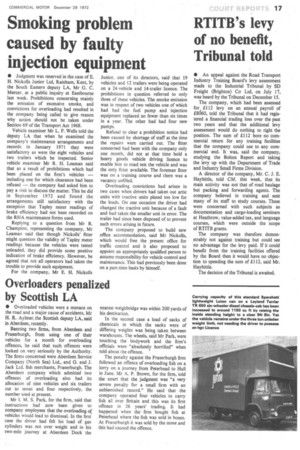Smoking problem caused by faulty injection equipment
Page 19

If you've noticed an error in this article please click here to report it so we can fix it.
• Judgment was reserved in the case of E. H. Nickolls Junior Ltd, Rainham, Kent, by the South Eastern deputy LA, Mr G. C. Mercer, at a public inquiry at Eastbourne last week. Prohibitions concerning mainly the emission of excessive smoke, and convictions for overloading had resulted in the company being called to give reason why action should not be taken under Section 69 of the Transport Act 1968.
Vehicle examiner Mr L. F. Wells told the deputy LA that when he examined the company's maintenance arrangements and records in January 1971 they were satisfactory as were the eight vehicles and two trailers which he inspected. Senior vehicle examiner Mr R. H. Leaman said that as a result of prohibitions which had been placed on the firm's vehicles — including one for which clearance had been refused — the company had asked him to pay a visit to discuss the matter. This he did in September 1972 and found the arrangements still satisfactory with the exception that Tapley meter readings of brake efficiency had not been recorded on the RHA maintenance forms used.
Replying to a question from Mr R. Champion, representing the company, Mr Leaman said that though Nickolls' fitter might question the validity of Tapley meter readings because the vehicles were tested unloaded, they did provide some positive indication of brake efficiency. However, he agreed that not all operators had taken the trouble to provide such equipment.
For the company, Mr E. H. Nickolls
Junior, one of its directors, said that 19 vehicles and 12 trailers were being operated on a 24-vehicle and 14-trailer licence. The prohibitions in question referred to only three of these vehicles. The smoke emission was in respect of two vehicles one of which had had the fuel pump and injection equipment replaced no fewer than six times in a year. The other had had four new pumps.
Refusal to clear a prohibition notice had been caused by shortage of staff at the time the repairs were carried out. The fitter concerned had been with the company only one month, did not at that time hold a heavy goods vehicle driving licence to enable him to road test the vehicle and was the only fitter available. The foreman fitter was on a training course and there was a vacancy unfilled.
Overloading convictions had arisen in two cases when drivers had taken out artic units with tractive units plated too low for the loads. On one occasion the driver had changed the tractive unit because of a fault and had taken the smaller unit in error. The trailer had since been disposed of to prevent such errors arising in future.
The company proposed to build new office accommodation, said Mr Nickolls, which would free the present office for traffic control and it also proposed to appoint an appropriately qualified person to assume responsibility for vehicle control and maintenance. This had previously been done on a part-time basis by himself.












































































